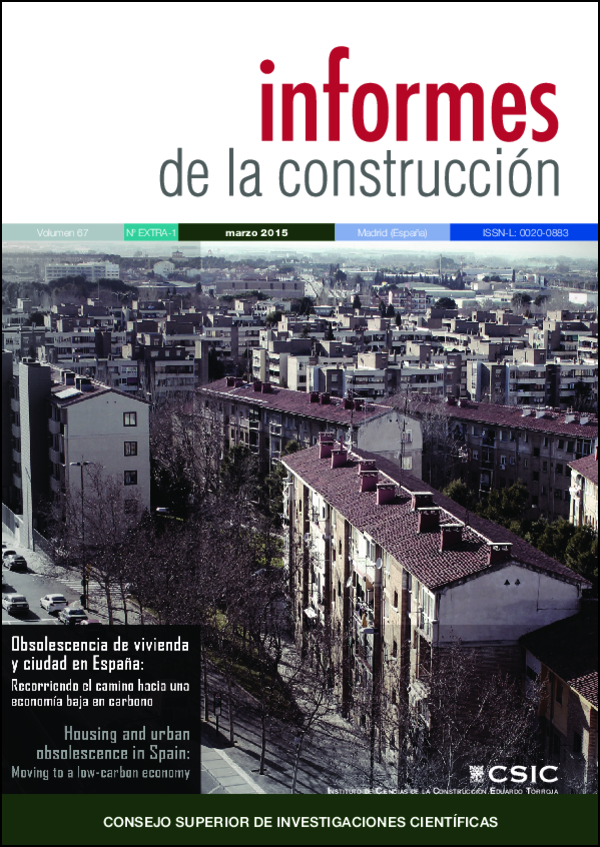Urban Remodeling, Transformation and Renovation. Three ways of intervening on twentieth century Social Housing
DOI:
https://doi.org/10.3989/ic.14.049Keywords:
Urban regeneration, rehabilitation, remodeling, social housingAbstract
Social housing built in Spain between 1939 and 1976 constitutes a widespread urban pattern in contemporary cities. Its initial conditions, along with the effects of time, have led to obsolescence, requiring refurbishment for revitalisation. Programs developed over the last few years not only have provided the buildings with the appropriate standards of living conditions, but also have articulated them as a whole, integrating them into the socio-economic configuration of their urban area. The evolution of these intervention models will be reviewed analyzing the Urban Remodeling of Orcasitas (Madrid) and Viviendas del Gobernador housing (Barcelona), the Urban Transformation of La Mina (Barcelona) and the Integral Renovation of Barrio de Lourdes (Tudela).
Downloads
References
(1) Castro, P., Molina, J. (1996). Un ejemplo de participación y renovación urbana: la remodelación de barrios en Madrid (España). Ciudades para un Futuro más Sostenible. http://habitat.aq.upm.es/dubai/96/bp258.html.
(2) Leoz, R., Ruiz, J. (1961). El poblado de Orcasitas (cont.). TA. Temas de Arquitectura y Urbanismo, 27: 922-926.
(3) Moya, L. (Coordinador) Barrios de Promoción Oficial de la Operación de Remodelación. Madrid 1979-1986. Madrid: Instituto de la Vivienda de Madrid (IVIMA), Conserjería de Ordenación del Territorio, Medio Ambiente y Vivienda Comunidad de Madrid.
(4) Moya, L. (1987). Análisis del Proceso de Remodelación y Realojamiento de Barrios en Madrid. Madrid: Escuela Técnica Superior de Arquitectura de Madrid (ETSAM)/ Instituto de la Vivienda de Madrid (IVIMA).
(5) Rodríguez-Villasante, T., Alguacil, K., Denche, C., Hernández Aja, A., León, C., Velázquez, I. (2009). Retrato de chabolista con piso. Análisis de redes sociales en la remodelación de barrios de Madrid. Madrid: ALFOZ-CIDUR/ IVIMA-SGV.
(6) Donato, J.E. (1965). Barrios altos de San Andrés. Cuadernos de arquitectura, 60: 19-40.
(7) Pradas, R. (2008). Vivendes del Governador. Una historia urbana. Barcelona: Institut Català del Sòl.
(8) Blos, D. (1999). Los polígonos de vivienda social: Perspectivas hacia su recuperación en España, Francia y Brasil. Tesis doctoral no publicada de la Universidad Politécnica de Cataluña. Barcelona: Escuela Técnica Superior de Arquitectura de Barcelona (ETSAB).
(9) López, R. (2009). Ordenar el territorio, proyectar la ciudad, rehabilitar los tejidos existentes. La relevancia del planeamiento a través de los premios nacionales de urbanismo. Madrid: Ministerio de la Vivienda.
(10) Díaz, C., Conrado, C., Llorens, I., Pardo, F., Hormías, E. (2012). Un estudio de caso: la rehabilitación de los edificios de viviendas del barrio de La Mina en Sant Adrià del Besòs (Barcelona). Análisis funcional y de las condiciones de seguridad, habitabilidad y mantenimiento. Informes de la Construcción, 64(525): 19-34.
(11) Barrio de la Mina. El Plan de Transformación. (2007). http://www.barrimina.cat/cast/index.php/plan-de-transformaciainmenu-39.
(12) Ruiz, L.G., Rubio, J. (2006). Nuevas propuestas de Rehabilitación Urbana en Zaragoza Estudio de Conjuntos Urbanos de Interés. Zaragoza: Sociedad Municipal de Rehabilitación Urbana de Zaragoza (SMRUZ).
Published
How to Cite
Issue
Section
License
Copyright (c) 2015 Consejo Superior de Investigaciones Científicas (CSIC)

This work is licensed under a Creative Commons Attribution 4.0 International License.
© CSIC. Manuscripts published in both the print and online versions of this journal are the property of the Consejo Superior de Investigaciones Científicas, and quoting this source is a requirement for any partial or full reproduction.
All contents of this electronic edition, except where otherwise noted, are distributed under a Creative Commons Attribution 4.0 International (CC BY 4.0) licence. You may read the basic information and the legal text of the licence. The indication of the CC BY 4.0 licence must be expressly stated in this way when necessary.
Self-archiving in repositories, personal webpages or similar, of any version other than the final version of the work produced by the publisher, is not allowed.















